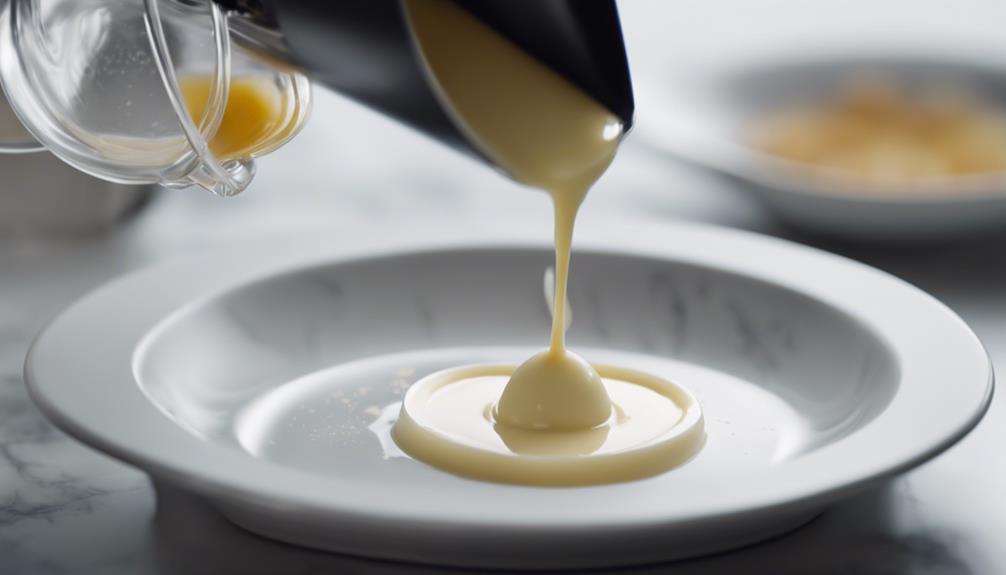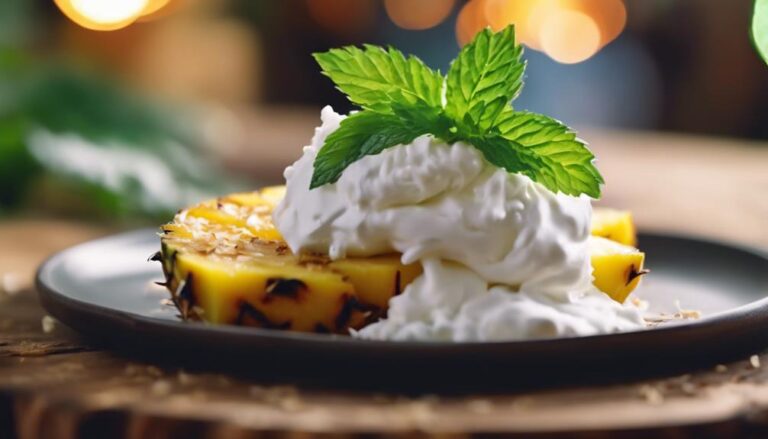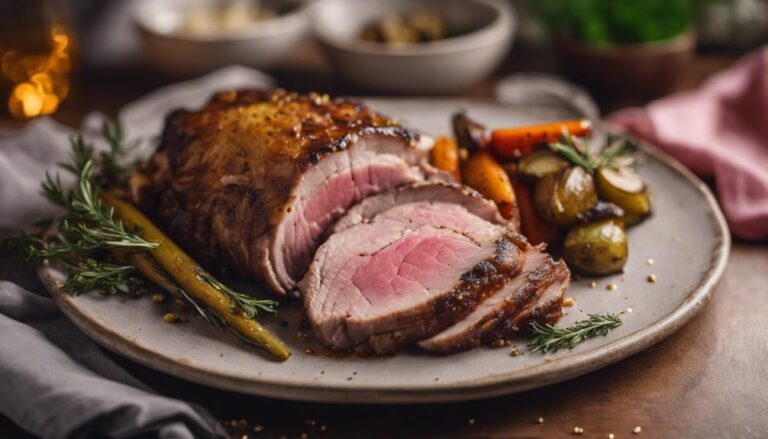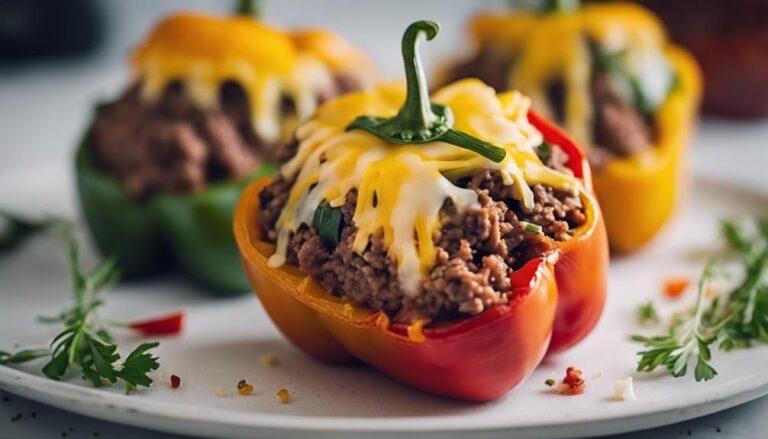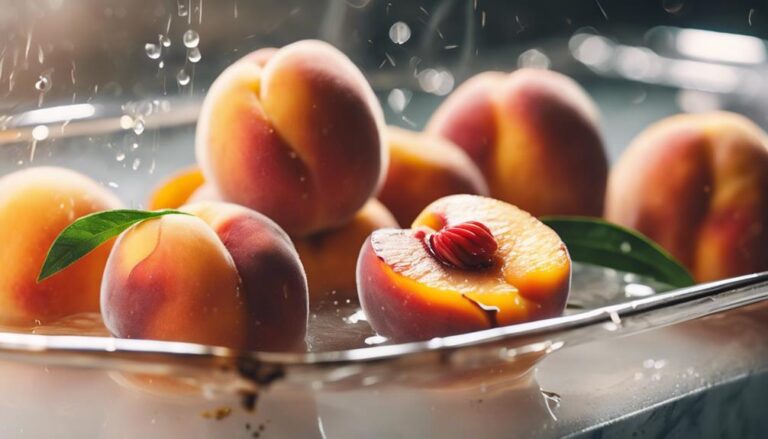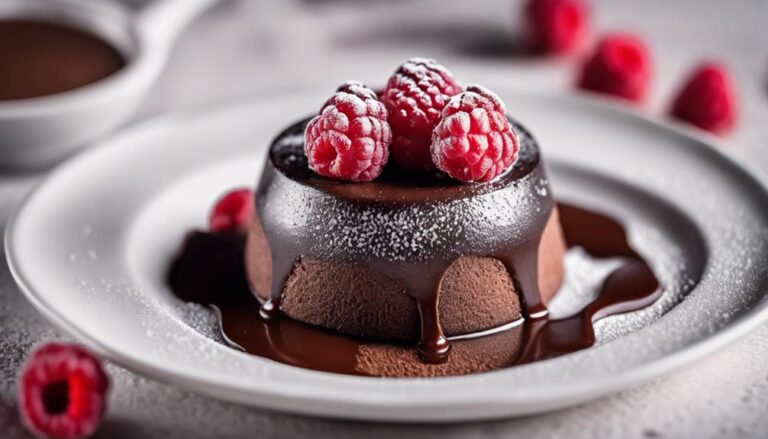Sous Vide Vanilla Bean Panna Cotta
Indulge in the sophisticated Sous Vide Vanilla Bean Panna Cotta for a creamy Italian dessert. The modern twist elevates the classic with a smooth texture. Use cream, sugar, and gelatin for the traditional base. Experiment with flavor pairings such as citrus zest or spices. Opt for honey or maple syrup as sweeteners. Showcase in elegant glassware with toppings like fresh berries or caramel sauce. To set it perfectly, refrigerate for about 4 hours. For a velvety finish, sous vide adds finesse. Discover how to enhance flavors and presentation while mastering the art of this delicious treat.
What You Will Learn Here
- Sous vide method ensures precise temperature control for perfect panna cotta texture.
- Vanilla bean infusion adds sophisticated flavor to the dessert.
- Slow cooking in a water bath enhances creaminess and smoothness.
- Gelatin bloom crucial for setting; follow instructions for optimal results.
- Experiment with different set times to achieve desired firmness.
Panna Cotta Origins
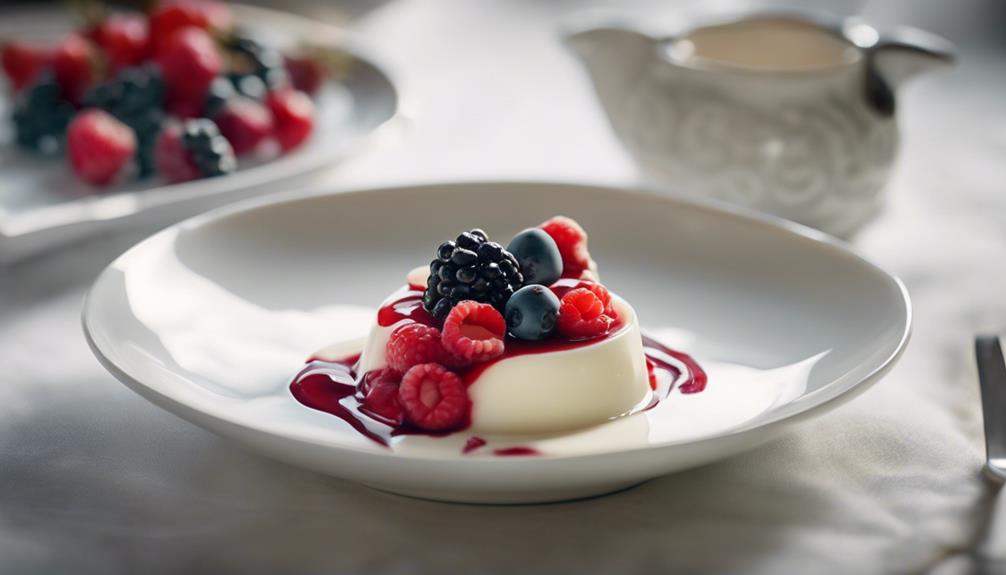
Panna Cotta, a traditional Italian dessert, has a rich history that traces back to the Piedmont region.
The simple yet elegant dessert is made from cream, sugar, and gelatin, resulting in a velvety texture that melts in your mouth.
Over time, modern variations have emerged, incorporating flavors like vanilla bean, berries, and even spices to elevate this classic treat.
Historical Panna Cotta
The origins of this delectable dessert can be traced back to the northern regions of Italy. Panna cotta, which translates to 'cooked cream,' has deep roots in Italian cultural traditions and culinary evolution. This creamy delicacy has been enjoyed for generations, reflecting the flavor profiles and dessert trends of its time.
Historically, panna cotta was a simple dessert made from cream, sugar, and gelatin, showcasing the elegance of minimalism in Italian cuisine. Over the years, this dessert has evolved to include variations with different flavorings like vanilla, coffee, chocolate, and fruit coulis. The versatility of panna cotta has allowed it to adapt to changing tastes while remaining a classic Italian favorite.
As dessert trends shifted towards lighter, more delicate flavors, panna cotta gained popularity for its silky texture and subtle sweetness. Its rise to fame in the culinary world is a tribute to the enduring appeal of this timeless Italian treat.
Ingredients and Variations
As you explore the origins of Panna Cotta and its evolution over time, understanding the key ingredients and various flavor variations becomes essential. Traditional Panna Cotta is made with simple ingredients like cream, sugar, and gelatin, creating a creamy and silky dessert. However, modern variations have expanded the possibilities by incorporating flavor infusions such as citrus zest, spices like cinnamon or cardamom, or even extracts like almond or coconut.
When it comes to sweeteners, you can experiment with alternative options like honey, maple syrup, or agave nectar to add a different depth of flavor. For those with dietary restrictions, dairy substitutions such as coconut milk or almond milk can be used to achieve a similar texture and taste. These variations allow for a versatile dessert that can cater to different preferences and dietary needs.
In terms of presentation ideas, consider serving Panna Cotta in elegant glassware topped with fresh berries, a drizzle of caramel or chocolate sauce, or a sprinkle of toasted nuts for added texture. The possibilities for customization are endless, making Panna Cotta a delightful dessert that can be tailored to suit any occasion.
Modern Panna Cotta
Initially crafted as a traditional Italian dessert, the evolution of this creamy delicacy has seen a modern twist with innovative flavor profiles and presentation styles. Modern panna cotta has embraced techniques like sous vide, a method where ingredients are vacuum-sealed and cooked in a water bath at precise temperatures, resulting in a perfectly smooth and creamy texture. This approach allows for precise control over the cooking process, ensuring a consistent outcome each time.
Contemporary desserts often feature vanilla bean flavors, adding a fragrant and rich taste to the classic panna cotta. The use of vanilla beans elevates the dish, providing a sophisticated and luxurious touch that appeals to modern palates. Alongside traditional flavors like berries or caramel, vanilla bean panna cotta has become a staple in many restaurants and home kitchens, offering a delightful balance of sweetness and sophistication.
As the culinary world continues to evolve, panna cotta remains a versatile dessert that can be adapted to suit various tastes and preferences, making it a beloved choice for dessert enthusiasts seeking a modern twist on a classic treat.
Key Panna Cotta Components
To ensure a successful panna cotta, prioritize selecting high-quality dairy ingredients and a reliable gelatin brand. Here are three key components to take into account when preparing this delectable dessert:
- Flavor Pairings: Experiment with different flavor combinations to enhance your panna cotta experience. Consider pairing vanilla bean panna cotta with fresh berries for a burst of fruity goodness or drizzling caramel sauce for a rich, indulgent twist.
- Texture Preferences: Achieving the perfect texture is essential for a delightful panna cotta. Whether you prefer a silky-smooth consistency or a slightly firmer texture, adjusting the gelatin ratio can help you achieve the desired result.
- Serving Suggestions: Elevate the presentation of your panna cotta by serving it in elegant glass ramekins or decorative molds. Garnish with mint leaves, edible flowers, or a sprinkle of cocoa powder to add a touch of sophistication to your dessert spread.
Top Panna Cotta Selections
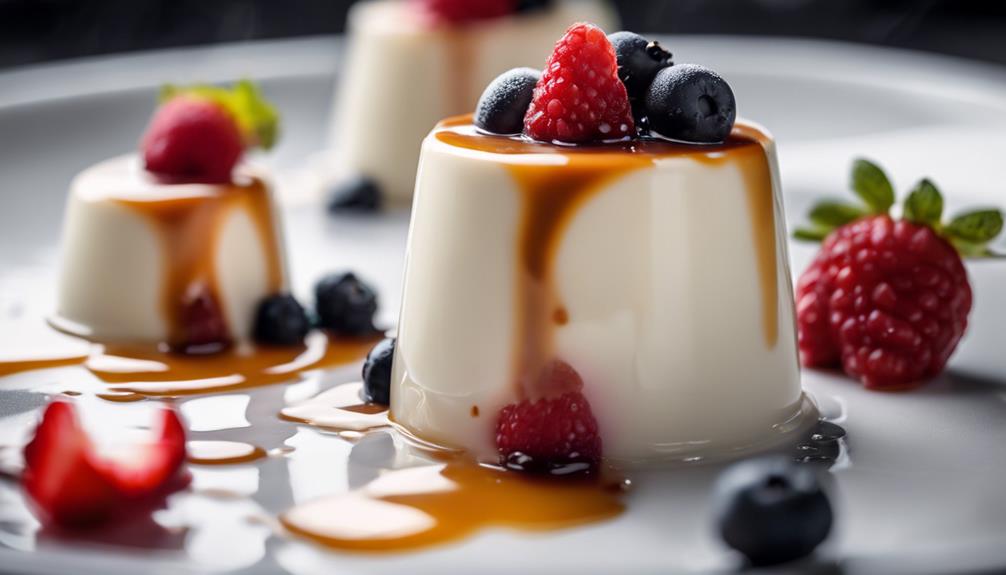
When it comes to selecting the top panna cotta variations, there are a few standout choices.
Consider trying the classic Vanilla Bean Panna Cotta recipe for a traditional yet delightful treat.
For a unique twist, explore a Lemon-Infused Panna Cotta that offers an invigorating citrus flavor.
Vanilla Bean Panna Cotta Recipe
Creating a delectable Vanilla Bean Panna Cotta involves infusing cream with vanilla beans for a rich and flavorful dessert. Here are some essential tips to elevate your Vanilla Bean Panna Cotta recipe:
- Flavor Pairings: Experiment with different flavor pairings to complement the vanilla base. Consider serving the panna cotta with fresh berries like raspberries or a drizzle of tangy passion fruit coulis for a burst of contrasting flavors.
- Presentation Tips: The presentation of your Vanilla Bean Panna Cotta can take it from simple to stunning. Use elegant ramekins or molds for shaping and consider garnishing with a delicate mint leaf or a sprinkle of edible flowers for a visually appealing touch.
- Texture Variation: For an added dimension, try incorporating textural elements like a crunchy almond praline or a smooth berry compote to contrast with the creamy panna cotta base, creating a more interesting dessert experience.
Unique Panna Cotta Variation
Consider elevating your Panna Cotta game with innovative twists and top-rated variations that promise to delight your taste buds.
- Flavorful Twist: Infuse your Panna Cotta with unique flavors such as lavender, matcha, or chai spice for a delightful surprise in every bite.
- Creative Presentation: Experiment with different molds and shapes to add visual appeal to your Panna Cotta. Try serving it in elegant glassware, mason jars, or even hollowed-out fruit for a fun and creative touch.
- Top-notch Toppings: Elevate your Panna Cotta by topping it with fresh fruits, a drizzle of honey or caramel, toasted nuts, or edible flowers for a burst of color and flavor that will impress your guests.
Lemon-Infused Panna Cotta Recipe
To elevate your Panna Cotta experience, explore the invigorating zest of a Lemon-Infused Panna Cotta recipe among the top selections available. This citrus twist on the classic creamy dessert brings a rejuvenating flavor and silky texture that will delight your taste buds.
Here are three reasons why you should consider trying this delightful Lemon-Infused Panna Cotta recipe:
- Bright Citrus Twist: The addition of fresh lemon zest and juice in this recipe adds a burst of vibrant, tangy flavor that beautifully complements the rich creaminess of the Panna Cotta. It's a delightful twist that brings a revitalizing and zesty kick to every bite.
- Creamy and Invigorating: This Lemon-Infused Panna Cotta offers a perfect balance of invigorating citrus notes and the smooth, velvety texture of a traditional Panna Cotta. Each spoonful is a luxurious experience that will leave you wanting more.
- Silky Smooth Texture: The combination of lemon-infused cream and gelatin results in a silky smooth texture that melts in your mouth, making each bite a heavenly sensation. It's a dessert that's both elegant and indulgent, perfect for any occasion.
Panna Cotta Setting Time
When it comes to Panna Cotta setting time, understanding the points is essential.
You'll learn about setting the Panna Cotta, the best temperature for setting, and troubleshooting any set issues you may encounter.
These points will guide you in achieving the perfect Panna Cotta consistency.
Setting the Panna Cotta
The ideal duration for the panna cotta to set is approximately 4 hours in the refrigerator. When setting your panna cotta, there are various techniques you can use to achieve that perfect consistency.
One common setting method involves using gelatin as a setting agent. Gelatin is a protein derived from collagen and is widely used in panna cotta recipes to help it set properly. If you're looking for alternatives to gelatin, agar-agar, a plant-based substitute, can also be used to set your panna cotta. Agar-agar is derived from seaweed and works well as a vegan-friendly setting agent.
Experimenting with different setting techniques and ingredients like gelatin alternatives can help you achieve the desired texture for your panna cotta. Whether you prefer the traditional gelatin method or opt for a plant-based alternative like agar-agar, the key is to allow ample time for the panna cotta to set properly in the refrigerator.
Best Temperature for Setting
For achieving the best results in setting your panna cotta, ensuring a precise temperature is essential. Temperature precision plays a significant role in determining the texture of your dessert. When heating the cream mixture, it's important to reach the ideal temperature for gelatin activation, usually around 140°F (60°C). This activates the gelatin, allowing it to create the desired consistency in your panna cotta.
Maintaining this temperature for a few minutes helps the gelatin fully dissolve, ensuring a smooth and creamy texture. The mixture shouldn't be heated too quickly or allowed to boil, as this can affect how the gelatin sets and result in a grainy or lumpy dessert.
Using a sous vide method can aid in controlling the temperature accurately throughout the setting process. This technique helps achieve a consistent texture by gently heating the panna cotta mixture without the risk of overheating. By paying attention to temperature precision during the setting phase, you can ensure a perfectly set panna cotta with a silky smooth finish.
Troubleshooting Set Issues
To troubleshoot any issues with setting time for your panna cotta, focus on maintaining consistent temperature control throughout the process. Start by ensuring the gelatin bloom is carried out correctly, allowing it to absorb enough moisture to set the dessert properly.
If your panna cotta isn't setting within the expected time frame, check the cooling technique. A rapid temperature drop can lead to uneven setting or prevent the dessert from firming up entirely. To avoid this, use a gentle cooling method, such as placing the panna cotta in an ice bath before transferring it to the refrigerator.
This gradual cooling process promotes even setting and helps prevent any potential texture issues. By paying attention to these details, you can troubleshoot and resolve any set time problems, ensuring your panna cotta turns out perfectly every time.
Final Thoughts
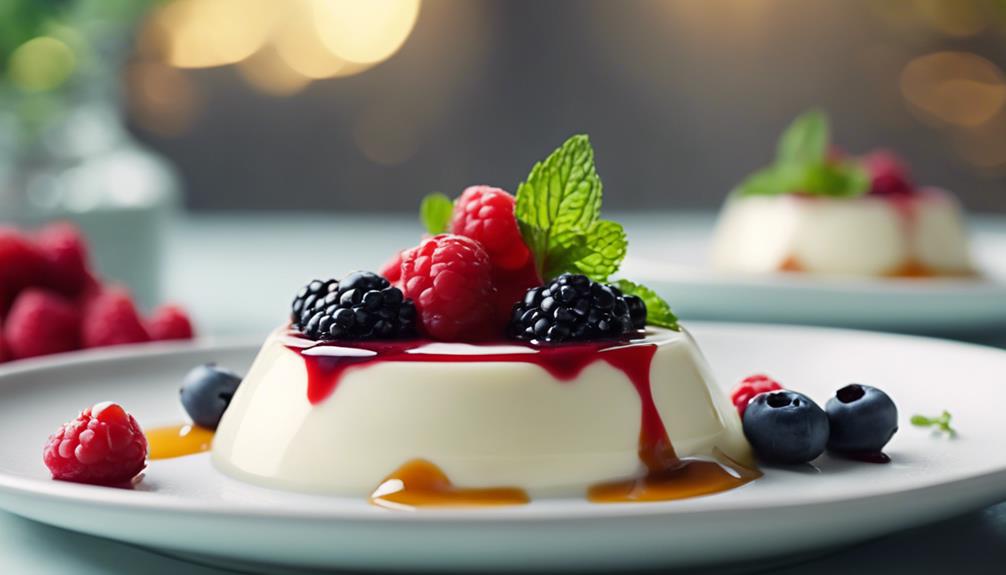
Consider wrapping up your experience with the Sous Vide Vanilla Bean Panna Cotta by reflecting on the journey and flavors that you have enjoyed. As you savor your final bites, think about your texture preferences. Did you enjoy the silky smoothness of the panna cotta, or would you prefer a slightly firmer set next time? Whether you prefer it more custard-like or jiggly, adjusting the cooking time can help tailor the texture to your liking.
Additionally, ponder the flavor pairings you experimented with. Did the vanilla bean shine through beautifully, or would you consider trying different flavor combinations next time? Perhaps a drizzle of berry coulis or a sprinkle of toasted nuts could complement the vanilla notes perfectly. Remember, culinary exploration is all about discovering what delights your taste buds the most.
Frequently Asked Questions
Can I Use Artificial Vanilla Extract Instead of Vanilla Bean?
Yes, you can substitute artificial vanilla extract for vanilla bean. While extract offers convenience, vanilla bean provides richer flavor. Adjust quantity for intensity. Customizing recipes with different ingredients can alter taste and texture, enhancing cooking variations.
How Do I Prevent Air Bubbles From Forming in the Panna Cotta?
To prevent air bubbles in your panna cotta, tap the container gently to release trapped air before chilling. Troubleshoot by adjusting gelatin amounts or using alternative stabilizers like agar agar. Texture control is crucial for a silky dessert.
Can I Substitute Gelatin With Agar-Agar for Vegetarians?
Yes, you can substitute gelatin with agar-agar for vegetarians. Agar-agar, a plant-based gelatin alternative derived from seaweed, works well in setting desserts like panna cotta. Follow the same measurement guidelines for a successful vegetarian-friendly dish.
What Is the Best Way to Unmold the Panna Cotta Without Breaking It?
To unmold panna cotta without breaking it, chill it for at least 4 hours. Run a knife along the edges, dip the mold in hot water for a few seconds, then invert onto a plate. Serve with fresh berries for a stunning presentation.
Can I Add Other Flavors Like Coffee or Citrus to the Panna Cotta?
Experimenting with flavors like coffee or citrus in your panna cotta can enhance the taste. Try ingredient alternatives to customize your creation. Guarantee texture consistency for a smooth finish and explore presentation techniques for a visually appealing dessert.
Conclusion
To sum up, sous vide vanilla bean panna cotta is a delicious and elegant dessert that can be easily made at home. By understanding the origins and key components of panna cotta, you can create a variety of flavor combinations to suit your taste.
Remember to allow sufficient setting time for the panna cotta to achieve the perfect texture. Experiment with different toppings and garnishes to elevate this classic Italian treat to new heights.
Enjoy the creamy goodness of panna cotta!
